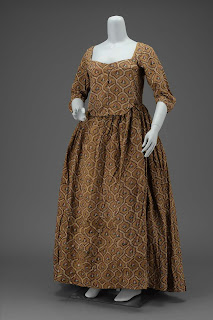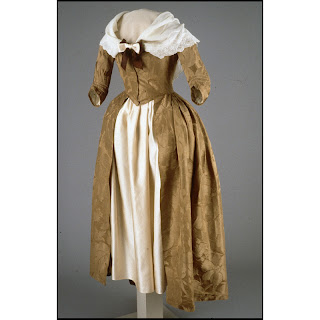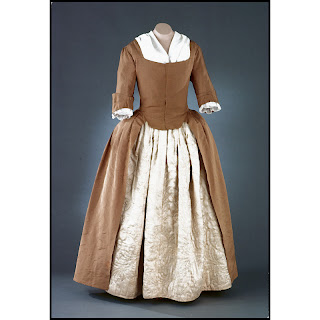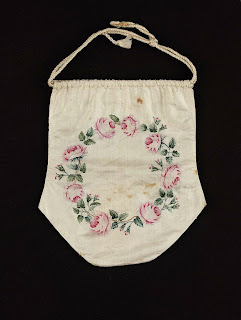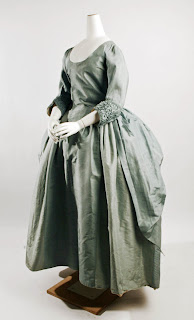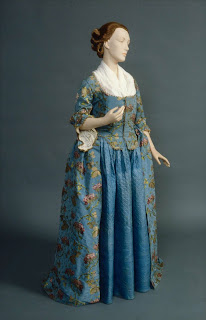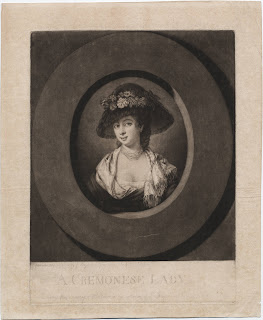I know Brown technically isn't part of the "rainbow" of colors (neither is pink), but it's variety of tones were still quite popular in the 18th century. It also seems a very practical color. I have a chocolate brown wool gown, and it never shows dust or dirt. I wore it all winter and it doesn't look dirty (trust me, it is). And while it may not be exciting, it is flattering. Again, definitions from Elephant's Breath & London Smoke.
Brown: fun-burnt, of a colour which may be made of a mixture of black with any other colour. Royal English Dictionary, 1775.
Chocolate: Mitella; ...commonly call'd Anotto or Arnotta in America. ... The Seeds of this Plant are ufed for dying a Chocolate Colour. Gardiners Dictionary, 1735.
Chesnut: Chesnut Brown is a deep reddish brown and yellowish brown. Werner's Nomenclature of Colours, 1814.
Cinnamon & Musk: Red and Brown. Dictionarium Polygraphicum, 1735.
Coffee: To give a browning, ftuff which has been juft dyed, is dipped in a folution of fulphat of iron. Elements of the Art of Dyeing, 1791.
Nut Brown: Nutbrown, brown as, or of the colour of a nut kept long. Royal English Dictionary, 1775.
Russet: of a reddifh brown; ufed by Sir Isaac Newton for grey. Coarfe, ruftic, or homefpun. Royal English Dictionary, 1775.
Snuff: a yellow-brown, the color of snuff. Primary Object Lessons, 1871.
Tawny: that is of a tanned, yellowifh, or dusky Colour. Dictionarium Anglo-Britannicum, 1708.
Umber: Umber Brown. Is a light Brown, a mixture of Yellowifh Brown and Grey. Philosophy of Mineralogy, 1798.
A note that while the first reference in the book to Coffee or Cafe au Lait is 1791, there were coffee shops even in the Colonies by the 1750s (broke ground in Wmsburg in 1747 for one).
Brown: fun-burnt, of a colour which may be made of a mixture of black with any other colour. Royal English Dictionary, 1775.
Chocolate: Mitella; ...commonly call'd Anotto or Arnotta in America. ... The Seeds of this Plant are ufed for dying a Chocolate Colour. Gardiners Dictionary, 1735.
Chesnut: Chesnut Brown is a deep reddish brown and yellowish brown. Werner's Nomenclature of Colours, 1814.
Cinnamon & Musk: Red and Brown. Dictionarium Polygraphicum, 1735.
Coffee: To give a browning, ftuff which has been juft dyed, is dipped in a folution of fulphat of iron. Elements of the Art of Dyeing, 1791.
Nut Brown: Nutbrown, brown as, or of the colour of a nut kept long. Royal English Dictionary, 1775.
Russet: of a reddifh brown; ufed by Sir Isaac Newton for grey. Coarfe, ruftic, or homefpun. Royal English Dictionary, 1775.
Snuff: a yellow-brown, the color of snuff. Primary Object Lessons, 1871.
Tawny: that is of a tanned, yellowifh, or dusky Colour. Dictionarium Anglo-Britannicum, 1708.
Umber: Umber Brown. Is a light Brown, a mixture of Yellowifh Brown and Grey. Philosophy of Mineralogy, 1798.
A note that while the first reference in the book to Coffee or Cafe au Lait is 1791, there were coffee shops even in the Colonies by the 1750s (broke ground in Wmsburg in 1747 for one).
Met Riding Habit Jacket, 1760
MFA Cotton Round Gown, late 18th c.
MFA Silk Damask Gown, 1770-80
CWF Silk Damask Gown, 1775-80
CWF Ribbed Silk Gown, 1760-80
Met Stays, 1780
V&A Riding Habit Jacket, 1750-59
V&A Riding Habit Jacket, 1750-59


